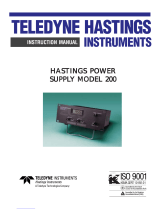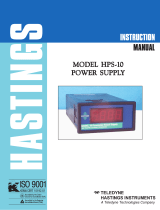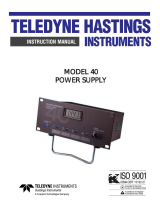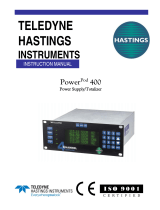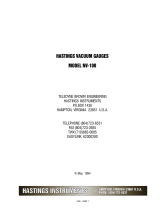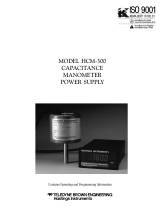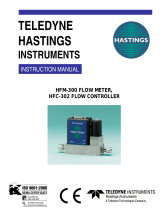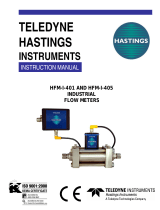
INSTRUCTION MANUAL
HFM-E-200/HFC-E-202 SERIES
FLOWMETERS/CONTROLLERS
TELEDYNE
HASTINGS
INSTRUMENTS
ISO 9001
CERTIFIED

HFM-E-200/HFC-E-202
Page 2 of 30
Manual Print History
The print history shown below lists the printing dates of all revisions and addenda created for this
manual. The revision level letter increases alphabetically as the manual undergoes subsequent updates.
Addenda, which are released between revisions, contain important change information that the user
should incorporate immediately into the manual. Addenda are numbered sequentially. When a new
revision is created, all addenda associated with the previous revision of the manual are incorporated into
the new revision of the manual. Each new revision includes a revised copy of this print history page.
Revision A (Document Number 138-102002)............................................................... October 2002
Revision B (Document Number 138-102004)............................................................... October 2004
Revision C (Document Number 138-082005) ................................................................ August 2005
Revision D (Document Number 138-032007) .................................................................March 2007
Revision E (Document Number 138-092008)............................................................September 2008
Revision E (Document Number 138-082010)................................................................. August 2010
Visit www.teledyne-hi.com for WEEE disposal guidance.
Hastings Instruments reserves the right to change or modify the design of its equipment without
any obligation to provide notification of change or intent to change.
The instruments described in this manual are designed for Class 2 installations
in accordance with IAW/IPC standards
CAUTION:
CAUTION:
The instruments described in this manual are des igned for INDOOR use only.
The instruments described in this manual are available with multiple pin-outs .
Ensure that all electrical connections are correct.
CAUTION:

HFM-E-200/HFC-E-202
Page 3 of 30
Table of Contents
1. INSTALLATION AND OPERATION.............................................................................................................................4
1.1. FEATURES....................................................................................................................................................................4
1.2. SPECIFICATIONS...........................................................................................................................................................5
1.3. OPTIONAL 4-20 MA CURRENT OUTPUT .......................................................................................................................6
1.4. OTHER ACCESSORIES...................................................................................................................................................6
1.4.1. Hastings Model 40, THPS-100 and THPS-400 Power Supplies .............................Error! Bookmark not defined.
2. INSTALLATION AND OPERATION.............................................................................................................................7
2.1. RECEIVING INSPECTION ............................................................................................................................................... 7
2.2. POWER REQUIREMENTS ...............................................................................................................................................7
2.3. OUTPUT SIGNAL...........................................................................................................................................................7
2.4. MECHANICAL CONNECTIONS....................................................................................................................................... 7
2.5. ELECTRICAL CONNECTIONS.........................................................................................................................................8
2.6. OPERATION..................................................................................................................................................................9
2.6.1. Operating Conditions.............................................................................................................................................9
2.6.2. Zero Check............................................................................................................................................................. 9
2.6.3. High Pressure Operation .....................................................................................................................................10
2.6.4. Blending of Gases................................................................................................................................................. 10
2.7. OPERATION WITH EXTERNAL DEVICES......................................................................................................................10
2.7.1. Operation with a Hastings power supply.............................................................................................................10
2.7.2. Operation with a power supply other than a Hastings.........................................................................................10
2.7.3. Operation with an external sensor. (Fig. 2.2)....................................................................................................11
2.7.4. Soft Start............................................................................................................................................................... 11
2.8. RANGE CHANGING:.................................................................................................................................................... 11
3. THEORY OF OPERATION...........................................................................................................................................12
3.1. OVERALL FUNCTIONAL DESCRIPTION: ......................................................................................................................12
3.2. SENSOR:.....................................................................................................................................................................12
3.3. ELECTRONICS: ...........................................................................................................................................................12
3.4. SHUNT: ...................................................................................................................................................................... 13
3.5. VALVE:......................................................................................................................................................................14
4. MAINTENANCE..............................................................................................................................................................15
4.1. AUTHORIZED MAINTENANCE..................................................................................................................................... 15
4.2. TROUBLESHOOTING ...................................................................................................................................................15
4.3. ADJUSTMENTS......................................................................................................................................................16
4.3.1. Calibration Procedure: (Figure 4.1).................................................................................................................... 16
4.3.2. Miscellaneous adjustments...................................................................................................................................17
4.4. INLET REMOVAL:....................................................................................................................................................... 17
4.5. PRINTED CIRCUIT BOARD REPLACEMENT..................................................................................................................17
4.6. SENSOR REPLACEMENT: ............................................................................................................................................17
4.7. ORIFICE CHANGES:....................................................................................................................................................17
4.7.1. HFC-E-202 Orifice...............................................................................................................................................18
4.8. REPLACEMENT PARTS ........................................................................................................................................19
5. CONVERSION FACTOR TABLE.................................................................................................................................20
6. WARRANTY....................................................................................................................................................................24
6.1. WARRANTY REPAIR POLICY ......................................................................................................................................24
6.2. NON-WARRANTY REPAIR POLICY .............................................................................................................................24
7. DRAWINGS......................................................................................................................................................................25
7.1. NOTES:....................................................................................................................................................................... 25

HFM-E-200/HFC-E-202
Page 4 of 30
1. Installation and Operation
The Hastings HFM-E-200 mass Flow-meter and HFC-E-202 Flow-controller are designed to accurately
measure and control mass flow over the range of 10 sccm to 30 slm, without corrections or
compensations for gas pressure and temperature with an accuracy of better than ±1% FS. Hastings mass
flow instruments do not require any periodic maintenance under normal operating conditions with clean
gases. No damage will occur from the use of moderate overpressures (~500 psi/3.45MPa) or overflows.
Instruments are normally calibrated with the appropriate standard calibration gas (nitrogen) then a
correction factor is used to adjust the output for the intended gas
1.1. Features
• LINEAR BY DESIGN. The HFM-E-200/HFC-E-202 series is inherently linear (no linearization circuitry is
employed). Should recalibration in the field be desired (a calibration standard is required), the
customer needs to simply set the zero and span points. There will be no appreciable linearity
change of the instrument when the flowing gas is changed.
• MODULAR SENSOR. The HFM-E-200/HFC-E-202 series incorporates a removable/replaceable sensor
module. Field repairs to units can be achieved with a minimum of production line downtime.
• LOW TEMPERATURE DRIFT. The temperature coefficient of span for the HFM-E-200/HFC-E-202
series is typically less than 0.05% of full scale/°C from 10-50°C. The temperature coefficient of zero
is typically less than 0.1 % of reading/°C from 10-50°C.
• CURRENT LOOP. The 4-20 mA option gives the user the advantages of a current loop output to
minimize environmental noise pickup.

HFM-E-200/HFC-E-202
Page 5 of 30
1.2. Specifications
Accuracy.............................................................................................................. ±1% full scale (F.S.)
Repeatability .............................................. <±0.125% of F.S.or ±0.075% of rdg. +0.05% F.S. (max)
Maximum operational pressure .............................................................................500 psi [3.45 MPa]
...................................................................................................(Option-P- up to 1000 psi [6.9 MPa]
Pressure coefficient ..............................................................................<0.0067% of reading/psi (N2)
...............................................................................................See pressure section for pressure errors.
Normal operating temperature ............................................10-50°C in non-condensing environment
Operating temperature limits ......................................................................... 0-60°C non-condensing
Temperature coefficient (zero) ........................................ maximum ±0.085%/°C (from 10 to 50oC)
Temperature coefficient (span) ......................................... maximum ±0.05%/°C (from 10 to 50oC)
Leak integrity .......................................................................................................... <1x10-9 std. cc/s.
Standard flow ranges .....................................................................5, 10, 20, 50, 100, 200, 500, sccm.
............................................................................................. 1, 2, 5, 10, 20, 30* slpm (N2 equivalent)
Standard output.......................................................................................... 0-5 VDC (load 2k Ohms)
Optional output ..................................4 -20 mA (load < 600 Ohms when loop return is @ common)
........................................................................(600-1200 Ohm load when loop return is @ -15VDC)
Power requirements..............................+(14 to 16) VDC @ 45 mA, -(14 to 16) VDC @ 185 mA
Wetted materials ......................................................................... 302 & 316 stainless steel, nickel 200,
........................................................Viton (optional), 82/18 Au-Ni braze, Kalrez, silver solder (trace)
Attitude sensitivity of zero .................................................. < ±0.25% F.S. for 90° without re-zeroing
................................................................................................................{N2 at 44.7 psia (308 KPa)}
Controller weight ..............................................................................................1.6 lb (0.6 kg) approx.
Meter weight.....................................................................................................1.6 lb (0.6 kg) approx.
Electrical connector ......................................................................................15 pin subminiature “D”
Standard fittings ................................................... 1/4” Swagelok®, 1/8” Swagelok®, VCR®, VCO®
* (Specifications may vary for instruments with ranges greater than 10 slpm)

HFM-E-200/HFC-E-202
Page 6 of 30
1.3. Optional 4-20 mA Current Output
An option to the standard 0-5 VDC output is the 4-20 mA current output that is proportional to flow. The
4 - 20 mA signal is produced from the 0 - 5 VDC output of the Flowmeter. The current loop output is
useful for remote applications where pickup noise could substantially affect the stability of the voltage
output.
The current loop signal replaces the voltage output on pin 3 of the “Edge” connector. The current loop
may be returned to either the power supply ground or the -15 VDC connections on the power supply. If
the current loop is returned to the power supply ground, the load must be between 0 and 600 ohm. If it
is returned to the -15VDC, the load must be between 600 and 1200 ohm. Failure to meet these
conditions will cause failure of the loop transmitter.
The 4-20 mA I/O option can accept a current input. The 0-5 VDC command signal on pin A can be
replaced by a 4-20mA command signal. The loop presets an impedance of 75 ohms and is returned to
the power supply through the valve common.
1.4. Other Accessories
1.4.1. Hastings Power supplies
Hastings Power Pod power supply/display units are available in one and four channel versions. They
convert 100, 115 or 230VAC to the ±15 VDC required to operate the flow meter and provide a digital
indication of the flow rate. Interface terminals for the retransmission of the flow meter analog output
signal are located on the rear of the panel.
The Power Pod 100 and 400 models are built with controllers in mind but will work with meters as well.
The Model 40 is for flow meters only. Throughout this manual, when reference is made to a power
supply, it is assumed the customer is using a Hastings power supply. Hastings PowerPod-100 and
PowerPod-400 power supplies are CE marked, but the Model 40 does not meet CE standards at this time.
The Model 40 and PowerPod-100 are not compatible with 4–20 mA analog signals. With the PowerPod
400, individual channels’ input signals, as well as their commands, become 4–20 mA compatible when
selected. The PowerPod-400 also sports a Totalizer feature. More information about the Power Pods can
be found on the Hastings web site. http://www.teledyne-hi.com/products/powerpod-series.htm
1.4.2. Interconnecting Cables
Cables are available from Hastings, in various lengths, to connect from the 15 pin "D" connector on the
back of the Power Pod directly to any of the 200 series and 300 series flow instruments (including digital
versions). More information about the available cables can be found in the Power Pod 400 bulletin on
the Hastings web site. http://www.teledyne-hi.com/pdfs/bulletins.htm

HFM-E-200/HFC-E-202
Page 7 of 30
2. Installation and Operation
This section contains the necessary steps to assist in getting a new Flowmeter/Controller into operation
as quickly and easily as possible. Please read the following thoroughly before attempting to install the
instrument.
2.1. Receiving Inspection
Carefully unpack the Hastings HFM-E-200/HFC-E-202 series instrument and any accessories that have also
been ordered. Inspect for any obvious signs of damage to the shipment. Immediately advise the carrier
who delivered the shipment if any damage is suspected. Check each component shipped with the
packing list. Insure that all parts are present (i.e., Flowmeter, power supply, cables, etc.). Optional
equipment or accessories will be listed separately on the packing list. There may also be one or more
OPT-options on the packing list. These normally refer to special ranges or special gas calibrations. They
may also refer to special helium leak tests, or high pressure tests. In most cases, these are not separate
parts, but special options or modifications built into the Flowmeter.
2.2. Power Requirements
The HFM-E-200/HFC-E-202 series requires ±15 VDC @ ±50 mA (HFM-E-200) +50 mA, -200 mA (HFC-E-202)
for proper operation. The supply voltage should be sufficiently regulated to no more than 50 mV ripple.
The supply voltage can vary from 14.0 to 16.0 VDC. Surge suppressors are recommended to prevent
power spikes reaching the instrument. The Hastings power supply described in Section 1.4.2 satisfies
these power requirements.
2.3. Output Signal
The standard output of the Flowmeter is a 0-5 VDC signal proportional to the flow rate. In the Hastings
power supply the output is routed to the display, and is also available at the terminals on the rear panel.
If a Hastings supply is not used, the output is available on pin 3 of the “Edge” connector and is
referenced to pin 2. It is recommended that the load resistance be no less that 2kW. If the optional 4-
20 mA output is used, the load impedance must be selected in accordance with Section 1.3.
2.4. Mechanical Connections
The Flowmeter may be mounted in any position as long as the direction of gas flow through the
instrument follows the arrow marked on the bottom of the Flowmeter case label. The preferred
orientation is with the inlet and outlet fittings in a horizontal plane (if operating with a dense gas or at
high pressures the instrument must be installed horizontally). When mounted in a different orientation
the instrument should be re-zeroed at zero flow with the system pressurized to the expected operating
pressure.
The smallest of the internal passageways in the HFM-E-200/HFC-E-202 series is the diameter of the
sensor tube, which is 0.0125” (0.31 mm), so the instrument requires adequate filtering of the gas supply
to prevent blockage or clogging of the tube.
The pressure regulator and the plumbing upstream must be of sufficient size to minimize changes in the
upstream pressure. When switching from full flow to zero flow, the inlet pressure of instrument should
rise to no more that 30% above the inlet pressure at full flow. In general, high capacity regulators and
large internal diameter plumbing help to make the system more stable. The pressure drop between the
regulator and the instrument due to line resistance should be minimized. The differential pressure
across the unit should be less than 6” of H
2
O at maximum flow.
There are two 8-32 threaded holes, located on the bottom of the base that can be used to secure it to a
mounting bracket, if desired (screws provided).
The standard inlet and outlet fittings for the 200/202 are 0.25” and 0.125” Swagelok (optional VCR or
VCO fittings). The O-rings for the end cap and the sensor are Viton (optional Kalrez or Neoprene). It is

HFM-E-200/HFC-E-202
Page 8 of 30
suggested that all connections be checked for leaks after installation. This can be done by pressurizing
the instrument (do not exceed 500 psig unless the Flowmeter is specifically rated for higher pressures)
and applying a diluted soap solution to the flow connections rated for higher pressures) and applying a
diluted soap solution to the flow connections.
2.5. Electrical Connections
If a power supply from Hastings Instruments is used, installation consists of connecting the HFM-E-
200/HFC-E-202 series cable from the “D” connector on the rear of the power supply to the “Edge”
connector on the top of the Flowmeter. If a different power supply is used, follow the instructions
below when connecting the flow meter.
This HFM-E-200/HFC-E-202 series requires Hastings cable #65-854. Use of any other cable can severely
damage the instrument and void the warranty. Figure 2.1 shows the schematic layout for connecting the
instrument to an appropriate power supply.
The power supply used must be capable of supplying +15VDC at 50mA and -15VDC at -200mA for each
controller. These voltages must be referenced to a circuit Common terminal. Connect -15VDC to pin F
and +15VDC to pin 4.
Pins 2, B and C are all Commons and they are connected together internally with solder jumpers to
ensure compatibility with legacy flow controllers. At least one of these Common pins must be connected
to the Common pin on the power supply. However for new designs and for installations with long cable
runs between the transducer and the power supply it is recommended that pin C be isolated from the
other Common pins of the transducer and provided a separate wire to connect it to the power supply
Common.
This pin carries the valve current and under conditions when the impedance of the wire connecting the
transducer Common to the power supply Common is high, tying these Commons together at the
transducer can create cross-talk that may result in flow instabilities or errors in the Command signal or
the Flow Output signal. In order to isolate pin C, solder jumpers JP8 and JP10 must be unsoldered while
JP7 remains soldered. This will be performed at assembly time in the factory if there is an indication at
the time of order that this is desired or it can be performed in the field. The Common pins can be
reconfigured to put the valve return current on different pins. Consult factory if it is necessary to match
previously installed wiring.
Figure 2.1

HFM-E-200/HFC-E-202
Page 9 of 30
Pin 1 is the case ground. It should be connected to the cable shield if available and to the AC ground at
the power supply.
Pin 3 is the output signal from the flow controller. This output will be 0-5VDC, 5VDC being 100% of rated
or full flow. Pin A is the command input. This should be a 0-5VDC signal and must be free of spikes or
other electrical noise, as these will generate false flow commands that the controller would attempt to
flow.
If a valve override switch is not desired, the unit is ready for use at this time. If the override switch is
desired, connect the center pin of a single pole, three-position switch with the center off position to pin
J. Connect +15VDC to one end of the switch, and -15VDC to the other end. This will result in the valve
being full open when +15VDC is supplied to pin J, off when -15VDC is supplied and auto-control when
there is no connection to pin J (OPEN-AUTO-CLOSE). This setup will be adequate for most purposes, but
there will be a small delay for capacitors to charge between switch operation and control override.
2.6. Operation
The standard instrument output is a 0 - 5 VDC out and the signal is proportional to the flow i.e., 0 volts
= zero flow and 5 volts = 100% of rated flow. The 4 - 20 mA option is also proportional to flow, 4 mA =
zero flow and 20 mA = 100% of rated flow. It is suggested that all connections be checked for leaks after
installation. This can be done by pressurizing the instrument (do not exceed 500 psig unless the
instrument is specifically rated for higher pressures) and applying a diluted soap solution to the
connections.
2.6.1. Operating Conditions
For proper operation, the combination of ambient temperature and gas temperature must be such that
the Flowmeter temperature remains between 10 and 50°C. (Most accurate measurement of flow will be
obtained if the Flowmeter is zeroed at operating temperature as temperature shifts result in some zero
offset.) The HFM-E-201/HFC-E-203 series is intended for use in non-condensing environments only.
Condensate or any other liquids which enter the Flowmeter may destroy its electronic components.
2.6.2. Zero Check
Turn the power supply on if not already energized. Allow for a 1 hour warm-up. Stop all flow through
the instrument and wait 2 minutes. Caution: Do not assume that all metering valves completely shut
off the flow. Even a slight leakage will cause an indication on the meter and an apparent zero shift. For
the standard 0-5 VDC output, adjust the zero potentiometer located on the lower outlet side of the
Flowmeter until the meter indicates zero. For the optional 4-20 mA output, adjust the zero
potentiometer so that the meter indicates slightly more than 4 mA, i.e. 4.03 to 4.05 mA. This slight
positive adjustment ensures that the 4-20 mA current loop transmitter is not in the cut-off region. The
error induced by this adjustment is approximately 0.3% of full scale. This zero should be checked

HFM-E-200/HFC-E-202
Page 10 of 30
periodically during normal operation. Zero adjustment is required if there is a change in ambient
temperature, or vertical orientation of the Flowmeter/controller.
2.6.3. High Pressure Operation
When operating at high pressure, the increased density of gas will cause natural convection to flow
through the sensor tube if the instrument is not mounted in a level position. This natural convection
flow will be proportional to the system pressure. This will be seen as a shift in the zero flow output that
is directly proportional to the system pressure.
2.6.4. Blending of Gases
In the blending of two gases, it is possible to maintain a fixed ratio of one gas to another. In this case,
the output of one flow controller is used as the reference voltage for the set point potentiometer of a
second flow controller. The set point potentiometer then provides a control signal that is proportional
to the output signal of the first flow controller, and hence controls the flow rate of the second gas as a
percentage of the flow rate of the first gas.
EXAMPLE: Flow controller A has 0-10 slpm range with a 5.00 volt output at full scale. Flow controller B
has 0-1 slpm range with a 5.00 volt output at full scale. If flow controller A is set at 8 slpm, its output
voltage would be 4.00 volts (8 slpm/10 slpm x 5.00 volts = 4.00 volts). If the output signal from flow
controller A is connected to the command potentiometer of flow controller B, it then becomes a variable
reference voltage for flow controller B proportional to the flow rate of flow controller A.
If the set point potentiometer of flow controller B is set at 50% of full scale, and the reference voltage
from flow controller A is 4.00, then the command signal going to flow controller B would be 2.00 volts
(4.00 volts x 50.0% = 2.00 volts). The flow of gas through flow controller B is then controlled at 0.4 slpm
(2.00 volts/5.00 volts x 1 slpm = 0.4 slpm).
The ratio of the two gases is 20:1 (8 slpm/0.4 slpm). The % mixture of gas A is 95.2 (8slpm/84slpm and
the % mixture of gas B is 4.8% (0.4 slpm/8.4 slpm).
Should the flow of flow controller A drop to 7.8 slpm, flow controller B would drop to 0.39 slpm, hence
maintaining the same ratio of the mixture. (7.8 slpm/10 slpm x 5v = 3.90v x 50% = 1.95v; 1.95v/5.00v x 1
slpm = 3.9 slpm; 7.8 slpm: 0.39 slpm = 20:1)
2.7. Operation with External Devices
2.7.1. Operation with a Hastings power supply.
There are two controls for each flow controller connected to a Hastings power supply. A switch labeled
“OPEN; AUTO; CLOSED” (valve over ride THPS 400 only) and a potentiometer labeled “COMMAND”. For
normal operation, the valve over ride switch will be in the “AUTO” position. The “CLOSE” position
removes all power from the valve, shutting off flow regardless of the command pot setting. The “OPEN”
position applies full available valve voltage to the valve, causing it to open, regardless of the command
pot setting. The “OPEN” position is useful for purging systems. It is recommended that the valve over
ride switch not be left in this position for extended periods of time, with no flow through the controller,
as a small positive zero shift may be observed.
The “COMMAND” pot adjusts the Analog command signal sent to the flow controller. The setting for
each controller connected to the power supply can be observed. (Depending on how the power supply
was set up, the display could indicate in flow units or percent of full scale).
2.7.2. Operation with a power supply other than a Hastings.
The flow controller must be connected to the power source as specified in section 2.6. In general, a 0-5
VDC command signal proportional to the intended flow (0 volts = zero flow; 5 volts = 100% of rated flow)
must be applied to pin A of the “Edge” connector. A 0-5 VDC signal proportional to the flow rate
through the instrument will be present on pin 3 of the “Edge” connector. The control mode is selected
via pin J of the “Edge” connector. Apply +15 volts for full open, -15 volts for closed and allow pin J to
float for flow proportional to the command voltage. Refer to your power supply manual for the specifics
of implementing these parameters.

HFM-E-200/HFC-E-202
Page 11 of 30
2.7.3. Operation with an external sensor. (Fig. 2.2)
In some instances, it might be desirable to use an external sensor to provide process information to the
control circuitry in the flow controller. For example, you might want to control the pressure in a
vacuum system by adjusting the rate at which the system is backfilled with a gas. The new, enhanced
HFC series of flow controllers have provision for accepting a 0-5VDC output from an external sensor at
pin 8 of the “Edge” connector. To activate this feature, the cover of the HFC must be removed to gain
access to PC-888 and move a jumper on JP3. JP3 is a three pin jumper block located just below the
“Edge” connector. In the normal operating mode, the jumper covers the bottom two pins. To select
“External Sensor”, move the jumper to the upper two pins. This swaps the flow input to the controller
circuit from the Flowmeter output to pin 8 of the “Edge” connector.
2.7.4. Soft Start
The response of the control circuit to sudden changes in the Command signal is set at the factory for
fast, stable response and minimal overshoot. If any overshoot is a problem in a particular system, it is
possible to slow down the controller response to sudden Command changes. Remove the outer cover
from the instrument and remove pin jumper JP6 this will insert an R-C filter with a two second time
constant into the command circuit. This will slow down the reaction of the controller to step changes in
the Command signal and will ensure that there is no overshoot or undershoot in actual gas flow.
2.8. Range Changing:
The range of the flow controller can be changed in the field if recalibration facilities are available. The
flow controller may require a different orifice and different laminar Flowmeter element (shunt), which
can be purchased separately from the factory. A listing of the orifices and shunts are available and their
flow rates can be found in Section 4.8.
The range of the small tube shunts can be changes by changing the front disk, consult factory for more
information on disk options.
Figure 2.1

HFM-E-200/HFC-E-202
Page 12 of 30
3. Theory of Operation
This section contains an overall functional description of HFC Flow Controllers. Detailed schematics and
parts lists can be found at the end of the manual in Section 6.0. In this section and other sections
throughout this manual, when a power supply is mentioned, it is assumed that the customer has a
Hastings Power Supply. These sections are not applicable if another type of power supply is used.
3.1. Overall Functional Description:
The HFC Flow Controller consists of a sensor, electronic
circuitry, a shunt and a valve. The sensor measures the
flow rate from 0 to 10 sccm of the gas to be metered. The
shunt divides the flow such that the flow through the
sensor is a precise percentage of the flow through the
shunt. The flow through the sensor and the shunt is
always laminar. The circuit board amplifies the sensor
output and uses this output to control the valve position.
The valve is an automatic metering solenoid type; its
height off the seat is controlled by the voltage in its coil.
All of these components working together result in a fast,
stable flow controller.
3.2. Sensor:
The Hastings HFM-E-200/HFC-E-202 series operates on a unique thermal electric principle whereby a
metallic capillary tube is heated uniformly by a resistance winding attached to the midpoint of the
capillary (see Figure 3.1). Thermocouples TC-1 and TC-2 are welded at equal distances from the
midpoint and develop equal outputs at zero flow.
When flow occurs through the tubing, heats is transferred from the tube to the gas on the inlet side, and
from the gas back to the tube on the outlet side creating an asymmetrical temperature distribution (see
Figure 3.2). The thermocouples sense this decrease and increase in the capillary tube temperature and
produce a millivolt output signal proportional to that change.
For a constant power input, the differential thermocouple output is a function of the mass flow rate and
the heat capacity of the gas. Since the heat capacity of many gases is relatively constant over wide
ranges of temperature and pressure, the Flowmeter may be calibrated directly in mass units for those
gases. Changes in gas composition usually only require application of a simple multiplier to the air
calibration to account for the difference in heat capacity and thus the Flowmeter is capable of
measuring a wide variety of gases. The HFM sensor measures approximately 10 sccm. Full scale flow.
3.3. Electronics:
The Hastings HFM-E-200/HFC-E-202 series uses a thermal flow sensor to measure through a capillary
tube, which is a fixed percentage of the total flow through the instrument. This sensor develops an
output signal proportional to flow which is approximately 1 mv full scale magnitude. This signal is
amplified by the meter circuitry until is 0-5.00 VDC. This 5 volt output is sent back to the power supply
and to the Flowmeter circuitry, if applicable. At the power supply the 5 volt output is sent to the
terminals on the back and to the decoding circuitry in the display which converts it to a 3-digit output.
The controller circuitry utilizes the Command and the Flow voltages as input signals. The 0-5VDC
command signal is subtracted from the 0-5VDC flow signal creating an error signal. This signal is
amplified and causes the solenoid valve to move. The amount and direction of the movement is
dependent upon the value and the sign of the error signal, and tends to minimize the error signal.
Figure 3.1

HFM-E-200/HFC-E-202
Page 13 of 30
3.4. Shunt:
Measurement of flow rates higher than the 10 sccm full scale is achieved by dividing the flow with a
fixed ratio shunting arrangement, as is illustrated in Figure 3.3. This is accomplished by placing the
measuring capillary tube parallel with one or more dimensionally similar channels, called a laminar flow
element (LFE). Therefore, the sensor only needs to heat the gas passing through the capillary tube
resulting in low power requirements, while retaining all the mass measuring characteristics.
The HFM-E-200/HFC-E-202 series has many different shunts. The low range shunt consists of tubes
inserted into a cylindrical base. This shunt is adjustable for ranges from 0-10 sccm to 0-180 sccm (see
Figure 3.4). The medium range shunts consists of a piece of stainless steel foil welded to a solid steel
center core. The high range shunts consists of a corrugated stainless steel ribbon wound into a coil and
fused.
Figure 3.2
Figure 3.4
Figure 3.3
Figure 3.5

HFM-E-200/HFC-E-202
Page 14 of 30
3.5. Valve:
The control valve is an “automatic metering solenoid” valve. While most solenoids operate in either the
fully open or fully closed state, the automatic metering solenoid valve is designed to control flow (see
Figure 3.6). A spring, connected to the plunger assembly, holds a magnetic plunger tightly against an
orifice to shut off flow. The magnetic plunger is surrounded by an electrical coil, which when energized
with electrical current lifts the plunger off the orifice and allows flow to pass between the orifice and
the plunger seat. Controlling the current through the coil controls the distance between the orifice and
the plunger seat, thus effectively controlling the flow through the valve. This current is controlled by a
feedback loop that matches the transducer output with the command voltage.
Figure 3.6

HFM-E-200/HFC-E-202
Page 15 of 30
4. Maintenance
This section contains service and calibration information. Some portions of the instrument are delicate.
Use extreme care when servicing the flow controller. The potentiometer positions and the electrical
components referred to in the troubleshooting section can be found in Section 6.0 on the electrical
component layout drawing.
4.1. Authorized Maintenance
With proper care in installation and use, the flow controller will require little or no maintenance. If
maintenance does become necessary, most of the instrument can be cleaned or repaired in the field.
Some procedures may require recalibration. Do not attempt these procedures unless facilities are
available. Entry into the sensor or tampering with the printed circuit board will void warranty. Do not
perform repairs on these assemblies while unit is still under warranty.
4.2. Troubleshooting
SYMPTOM: Output reads 40% of flow with no flow. Zero pot has no effect.
CAUSE: Power supply locked up or shorted out.
ACTION: Turn off power supply for a few seconds, then turn back on. If this proves ineffective,
disconnect the unit from the power supply. If power supply display does not return to zero, then a
regulator chip in the power supply is probably burned out. Check supply voltages and replace faulty
regulator. If display returns to zero after disconnecting the power supply from the unit there is a short
in the unit to ground. Check capacitors C38 & C39 first.
SYMPTOM: Command is zero, but flow remains.
CAUSE: Orifice out of adjustment or faulty op-amp
ACTION: Check valve voltage at connector pins C & D. If voltage is less than 3.00 VDC, then turn orifice
clockwise until flow stops. If voltage is greater than 3.00 VDC. Replace PC Board.
SYMPTOM: Output of unit is proportional to flow but extremely small and not correctable by span pot.
CAUSE: Sensor is not being heated.
ACTION: Unplug connector J2. Check the following resistance: The resistance between pins 2 & 3 of
the sensor should be approximately 2500 ohms (see Figure 3.1 on page 8). The resistance between pins 1
& 4 should be approximately 2.3 ohms. The resistance between pins 2 & 3 and the base of the sensor
should be essentially infinite. If not, replace the sensor unit. If sensor reads O.K., check the voltage
output on pins 2 & 3 of the jack in the board. If it does not read approximately 22 VDC then replace PC
Board.
SYMPTOM: Sensor has proper resistance readings, but little or no output with flow.
CAUSE: Plugged sensor.
ACTION: Shut off gas supply and power supply. Remove cover and PC board from unit. Remove sensor
assembly and examine. If sensor has evidence of plugging, clean or replace as applicable

HFM-E-200/HFC-E-202
Page 16 of 30
SYMPTOM: Flow controller oscillates.
CAUSE: Flow controller not adjusted for the dynamics of the flow system.
ACTION: Check upstream and downstream pressures. The gas supply regulator should not have
excessive lockup when flow shuts off. Also ensure that there is not a large drop in pressure between the
regulator and the instrument due to line resistance. Oscillations can also be caused if a large flow
restriction is pneumatically close to the downstream end of the flow controller. The differential
pressure across the unit must be between the values specifications on the original order.
SYMPTOM: Little or no flow, even with a maximum SetPoint value.
CAUSE: Plugged orifice.
ACTION: Verify the presence of a pressure across the instrument. If present, shut off gas supply and
power supply. Remove orifice per Section 4.9. Examine orifice. If plugged, clean or replace as
applicable. Reassemble valve.
SYMPTOM: Flowmeter reads other than 0.00 VDC with no flow, or there is a small flow when Flowmeter
reads 0.00 VDC.
CAUSE: ZERO potentiometer is out of adjustment.
ACTION: Shut off all flow. Adjust ZERO potentiometer until output reads 0.00 VDC.
SYMPTOM: Flowmeter out of calibration and nonlinear.
CAUSE: Leaks in gas inlet or outlet fittings.
ACTION: Check all fittings for leaks by placing soap solution on all fittings between gas supply and final
destination of gas. Check Flowmeter for leaks. Replace “O” rings if required or recalibrate as
necessary.
4.3. ADJUSTMENTS
4.3.1. Calibration Procedure: (Figure 4.1)
NOTE: Adjusting the SPAN pot will require the use of a
calibration reference in Step 5.
1. Connect power cable to Edge Connector as specified in Section
2.7. Allow instrument to warm up for 30 minutes. Ensure that for at
least the last 3 minutes there is a controlled flow of gas thought the
instrument, shut off gas flow, wait 2 minutes.
2. Set ZERO (R19) potentiometer for 0.000 VDC output.
3. Turn on gas supply to inlet of instrument. Put Valve Override
switch into CLOSE position. Adjust the orifice underneath controller
to obtain zero flow. Put Valve Override switch into AUTO. Ensure that
full range flow can still be obtained at minimum inlet pressure.
4. Set command to 100%. Wait 2 minutes; adjust SPAN (R29) pot until the flow reference reads full
scale flow (5.000 VDC). NOTE: Perform this step only if a calibrated reference Flowmeter is available.
5. Record Flowmeter and flow reference outputs for flow rates of 20%, 40%, 60%, 80% and 100%.
Zero
S
p
an

HFM-E-200/HFC-E-202
Page 17 of 30
4.3.2. Miscellaneous adjustments
Periodically, during normal operation, the ZERO should be checked and adjusted when required. If the
instrument is not stopping the flow completely when command signal is Zero, the orifice may require
turning approximately 1/8 turn clockwise.
4.4. Inlet Removal:
The fitting on the inlet side must be removed to gain access to the filter or shunt assembly. First shut off
the supply of gas to the instrument. Disconnect the Swagelok fitting on the inlet and outlet sides of the
transducer, and remove it from the system plumbing. Carefully remove the inlet fitting, spring (if
present) and shunt, noting their order and proper orientation. The shunt can be severely damaged if
dropped. Examine the filter and shunt. If either is dirty or blocked, clean or replace as applicable.
Reassembly is the reverse of the removal procedure. Recalibration of the HFC is necessary.
4.5. Printed Circuit Board Replacement
In the unlikely event that the PC board fails, it is easily removed from the instrument and replaced with
a spare to minimize instrument downtime. Replacement of the PC board will require the instrument to
be recalibrated per Section 4.3.1.
Unplug the power cable from the top of the transducer. Remove the two jackscrews next to the “Edge”
connector and the two screws on the sides of the cover. Lift off the cover and unplug the four-wire
sensor plug and the two wire valve plug, noting their orientation prior to removal.
Remove the screw that holds the PC board to the sensor. Troubleshoot or replace as applicable.
Installation is the reverse of the above procedure. Recalibrate if any components were changed or if any
potentiometers were adjusted.
4.6. Sensor Replacement:
If the sensor fails or becomes plugged it can be removed. Remove the cover and the PC board per
Section 4.5 above. Remove the three bolts holding the sensor to the instrument base. Remove the
sensor from the base noting the two O-rings (Parker 2-005, V884-75) between the sensor and the base. If
the sensor is plugged it can be cleaned by running a fine wire (approximately 0.008" diameter) through
the tube. If sensor needs replacement, obtain another from the factory and install it. Ensure that O-
rings are clean and intact. Install O-rings on seating surface, then carefully place sensor over O-rings
and tighten down the three screws evenly. Replacement of sensor will require recalibration per Section
4.3.1.
4.7. Orifice Changes:
The orifice may require replacement if a flow range change is desired, if a large change in differential
pressures across the valve is desired or in the event that a small orifice becomes plugged. Replacement
orifices can be acquired from the factory. See Section 4.8 for the list of standard orifices and their flow
rates in air.
When using nonstandard pressures or gases that have specific gravities different than air (such as
hydrogen or helium), the diameter of the orifice must be calculated using the following procedure:
A) Determine the minimum expected upstream pressure (Pu) in PSI absolute and the maximum
expected downstream pressure (Pd) in PSI absolute for full flow conditions.
B) If Pu >2Pd, use formula 1; otherwise use formula 2.

HFM-E-200/HFC-E-202
Page 18 of 30
Where:
Formula 1: Formula 2:
u
P
Q
D
σ
0028.0
=
σ
d
Q
D
Ρ•ΔΡ
=
0014.0
D = Diameter in inches
Q = Flow rate in standard liters per minute
P = Pu - Pd in PSI
Pu = Upstream pressure in PSIA
Pd = Downstream pressure in PSIA
σ = Specific gravity of gas
Choose the orifice form Section 5.0 that has the closes larger diameter to the calculated diameter.
4.7.1. HFC-E-202 Orifice
To change the orifice in the HFC-E-202 series, turn the instrument upside-down and turn the orifice
counterclockwise with a 9/64” Allen wrench until it stops coming out. Then grasp the exposed orifice
end and pull it straight out. See Figure 4.2.
Prior to reinstallation of the orifice, inspect the two O-rings mounted on it for damage. Replace if cut or
gouged.
Lubricate the O-rings slightly with a silicone based grease, and the threads with anti-galling compound.
Push the orifice into its hole and screw it in until it is flush with the instrument base. Apply pressure to
the inlet side of the instrument.
Turn the Valve Override switch to CLOSE or unplug the instrument. Screw the orifice in a few more turns
until the flow through the instrument stops, then turn it an additional 1/8 turn clockwise.
PARKER O-RING
#2-008 VITON
ORIFICE
(see P/L per P/#
Fig 4.2

HFM-E-200/HFC-E-202
Page 19 of 30
4.8. REPLACEMENT PARTS
The following is a list of the available replacement parts and their factory stock numbers. The HFM-E-
200 and the HFC-E-202 shunts and sensor modules are interchangeable.
STOCK NO. DESCRIPTION AIR RANGE
81-270 30L - Shunt 24 - 36
81-269 20L - Shunt 16 – 24
81-268 10L - Shunt 8 – 12
81-267 5L - Shunt 4 – 6
81-266 2L - Shunt 1.6 - 2.4
1L - Shunt 0.8 – 1.2
81-265 500sccm - Shunt 400 – 600
81-263 150sccm - Shunt 120 – 180
81-262 70sccm - Shunt 60 – 132
81-261 20sccm - Shunt 12 – 60
81-260 10sccm - Shunt 8 – 12
28-13-298 Orifice 0.001”
28-13-299 Orifice 0.002”
28-13-167 Orifice 0.003”
28-13-168 Orifice 0.007”
28-13-169 Orifice 0.014”
28-13-171 Orifice 0.032”
28-13-172 Orifice 0.052”
28-13-173 Orifice 0.070”
81-314 SENSOR MODULE ALL MODELS
NOTE: Ranges listed are for Nitrogen.
To place an order or to obtain information concerning replacement parts, contact the factory or our
local manufacturer’s representative in you area. See below, or this manual’s last page for the address
or phone number. When ordering, include the following information:
Instrument model number
Part description
Hastings part number

HFM-E-200/HFC-E-202
Page 20 of 30
5. Conversion Factor Table
Rec
# Gas Symbol GCF Derived Density Density Synonyms Gamma R Z
(g/L)
25°C
(g/L)
0°C
(Cp/Cv)
/ 1 atm / 1 atm 25 J/gm*K
1 Acetic Acid C
2
H
4
F
2
0.4155 4 2.700 - 2.947 - Ethanoic Acid 1.2 125.88 2.0301
2 Acetic Acid, Anhydride C
4
H
6
O
3
0.2580 4 4.173 - 4.555 - Aceticanhydride 1.2 81.44 2.3384
3 Acetone C
3
H
6
O 0.3556 4 2.374 - 2.591 - 2-propanone 1.2 143.16 1.7504
4 Acetonitryl C
2
H
3
N 0.5178 4 1.678 - 1.832 - Methyl Cyanide 1.2 202.54 1.4462
5 Acetylene C
2
H
2
0.6255 4 1.064 - 1.162 - Ethyne 1.23 319.33 0.9792
6 Air Air 1.0015 1 1.185 - 1.293 - NA 1.4 287.00 1.0930
7 Allene C
3
H
4
0.4514 4 1.638 - 1.787 - Propadiene 1.2 207.53 1.3876
8 Ammonia NH
3
0.7807 2 0.696 - 0.760 - NA 1.32 488.21 0.6409
9 Argon Ar 1.4047 1 1.633 - 1.782 - NA 1.66 208.13 2.1243
10 Arsine AsH
3
0.7592 5 3.186 - 3.478 - NA 1.2 106.67 4.0839
11 Benzene C
6
H
6
0.3057 4 3.193 - 3.485 - NA 1.2 106.44 2.0636
12 Boron Trichloride BCl
3
0.4421 4 4.789 - 5.228 - NA 1.2 70.96 3.6531
13 Boron Triflouride BF
3
0.5431 4 2.772 - 3.025 - NA 1.2 122.62 2.4109
14 Bromine Br
2
0.8007 4 6.532 - 7.130 - NA 1.4 52.03 1.0000
15 Bromochlorodifluoromethane CBrClF
2
0.3684 4 6.759 - 7.378 - NA 1.2 50.28 4.2789
16 Bromodifluoromethane CHBrF
2
0.4644 4 5.351 - 5.841 - NA 1.2 63.51 4.3990
17 Bromotrifluormethane CBrF
3
0.3943 4 6.087 - 6.644 - NA 1.2 55.84 4.1546
18 Butane C
4
H
10
0.2622 2 2.376 - 2.593 - NA 1.09 143.05 1.6896
19 Butanol C
4
H
10
O 0.2406 4 3.030 - 3.307 - 1-Butanol, Butyl Alcohol 1.2 112.17 1.9233
20 Butene C
4
H
8
0.3056 4 2.293 - 2.503 - 1-Butene, 1-Butylene 1.2 148.19 1.6700
21 Carbon Dioxide CO
2
0.7526 1 1.799 - 1.964 - NA 1.22 188.93 1.7511
22 Carbon Disulfide CS
2
0.6160 4 3.112 - 3.397 - NA 1.2 109.20 3.0744
23 Carbon Monoxide CO 1.0012 4 1.145 - 1.250 - NA 1.4 296.84 1.0433
24 Carbon Tetrachloride CCl
4
0.3333 4 6.287 - 6.863 - Tetrachloromethane 1.2 54.05 3.6196
25 Carbonyl Sulfide COS 0.6680 4 2.456 - 2.680 - Carbon Oxysulfide 1.2 138.40 2.4230
26 Chlorine Cl
2
0.8451 4 2.898 - 3.163 - NA 1.4 117.26 3.9995
27 Chlorine Trifluoride ClF
3
0.4496 5 3.779 - 4.125 - NA 1.2 89.94 2.8970
28 Chlorobenzene C
6
H
5
Cl 0.2614 4 4.601 - 5.022 - NA 1.2 73.87 2.4954
29 Chlorodifluoroethane C
2
H
3
ClF
2
0.3216 4 4.108 - 4.484 - Ethane, 2-chloro-1,1-difluoro- 1.2 82.74 2.5119
30 Chloroform CHCl
3
0.4192 4 4.879 - 5.326 - Trichloromethane 1.2 69.65 3.5284
31 Chloropentafluoroethane C
2
ClF
5
0.2437 4 6.314 - 6.892 - NA 1.2 53.83 2.9778
32 Chloropropane C
3
H
7
Cl 0.3080 4 3.210 - 3.504 - Propylchloride 1.2 105.86 2.0756
33 Cisbutene C
4
H
8
0.3004 4 2.293 - 2.503 - Cis-2-butene 1.2 148.19 1.6672
34 Cyanogen C
2
N
2
0.4924 4 2.127 - 2.322 - NA 1.2 159.79 1.7626
35 Cyanogen Chloride ClCN 0.6486 5 2.513 - 2.743 - NA 1.2 135.26 2.4405
36 Cyclobutane C
4
H
8
0.3562 4 2.293 - 2.503 - Tetramethylene 1.2 148.19 1.7091
37 Cyclopropane C
3
H
6
0.4562 4 1.720 - 1.877 - Trimethylene 1.2 197.59 1.4440
38 Deuterium H
2
2
1.0003 4 0.165 - 0.180 - D
2
1.4 2062.13 0.3102
39 Diborane B
2
H
6
0.5063 5 1.131 - 1.235 - NA 1.2 300.49 1.0486
40 Dibromodifluoromethane CBr2F2 0.3590 4 8.576 - 9.361 - NA 1.2 39.63 5.2998
41 Dichlorofluoromethane CHCl
2
F 0.4481 4 4.207 - 4.592 - R21 1.2 80.78 3.2249
42 Dichloromethane CH
2
Cl
2
0.5322 4 3.472 - 3.789 - Methylene Chloride 1.2 97.90 3.0592
43 Dichloropropane C
3
H
6
Cl
2
0.2698 4 4.618 - 5.041 - 1,2-dichloropropane, 1.2 73.59 2.5291
44 Dichlorosilane H
2
SiCl
2
0.4716 5 4.129 - 4.506 - NA 1.2 82.32 3.3176
45 Diethyl Amine C
4
H
11
N 0.2256 4 2.989 - 3.263 - NA 1.2 113.68 1.9080
46 Diethyl Ether C
4
H
10
O 0.2235 4 3.030 - 3.307 - 1,1-oxybisethane 1.2 112.17 1.9215
47 Diethyl Sulfide C
4
H
10
S 0.2255 4 3.686 - 4.024 - 3-thiapentane, UN-2375 1.2 92.19 2.1300
Page is loading ...
Page is loading ...
Page is loading ...
Page is loading ...
Page is loading ...
Page is loading ...
Page is loading ...
Page is loading ...
Page is loading ...
Page is loading ...
/

